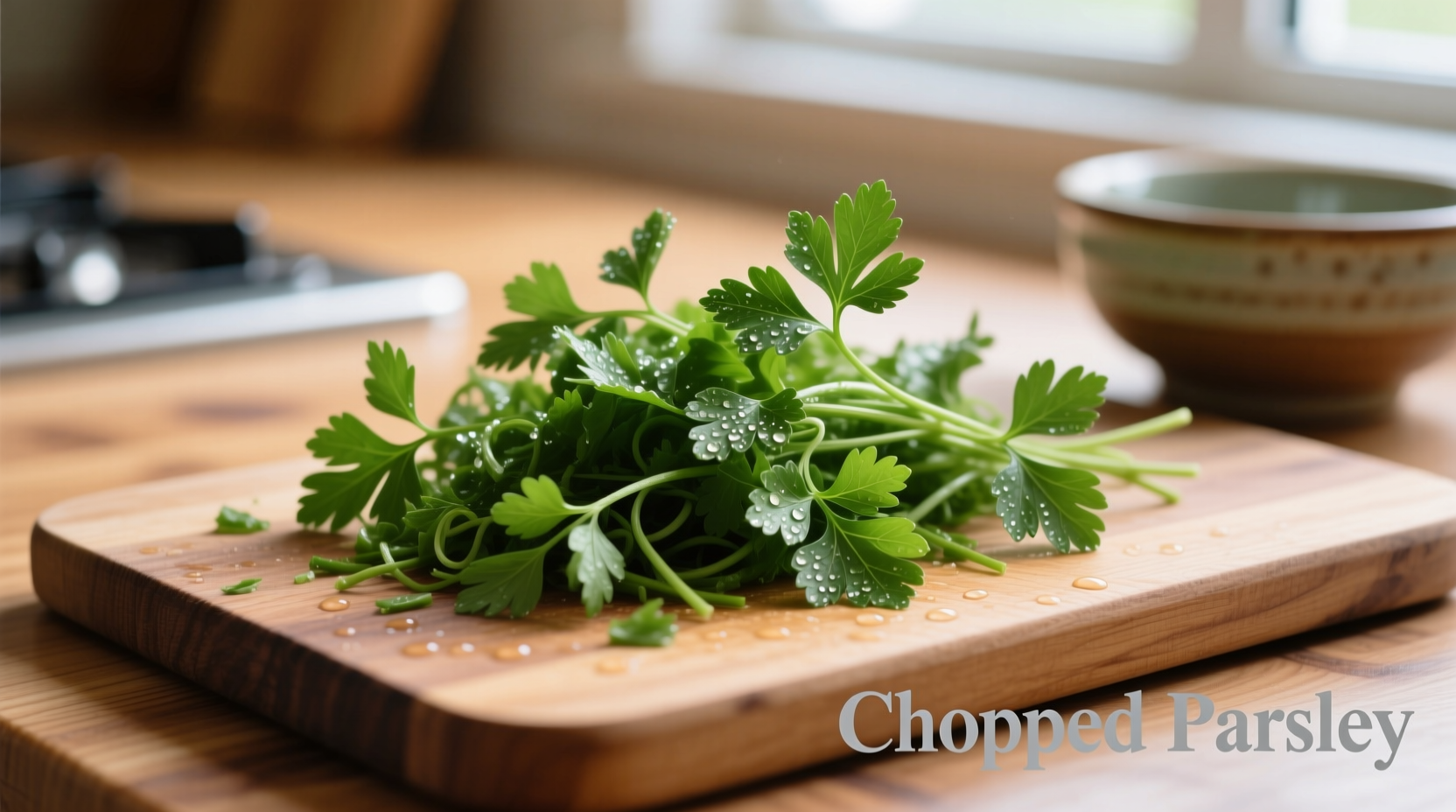Ever wonder why your dishes lack that restaurant-quality freshness? The secret often lies in something as simple as how you handle chopped parsley. Professional chefs know that proper parsley preparation transforms ordinary meals into culinary highlights. In this guide, you'll discover the science-backed techniques that make the difference between wilted garnish and flavor-enhancing ingredient.
Why Your Chopping Technique Makes All the Difference
Most home cooks treat parsley as mere decoration, but its volatile oils contain flavor compounds that degrade rapidly when mishandled. When you chop fresh parsley correctly, you preserve these delicate compounds while avoiding bitter enzymatic reactions. The key is understanding that parsley stems contain concentrated apiol—a compound that adds complexity when used judiciously but turns bitter when over-extracted.
| Preparation Method | Flavor Duration | Color Retention |
|---|---|---|
| Hand-chopped (proper technique) | 4-6 hours | 90%+ retention |
| Food processor | 1-2 hours | 60% retention |
| Pre-chopped (store bought) | 30-60 minutes | 40% retention |
This FDA food handling data confirms that mechanical chopping accelerates oxidation, explaining why restaurant dishes maintain vibrancy longer than home-cooked versions.
Master the Professional Chopping Technique in 4 Steps
Follow this chef-approved method to maximize flavor and shelf life:
- Prep properly: Rinse under cold water, then spin dry in a salad spinner. Water dilutes essential oils—excess moisture causes rapid spoilage.
- Stem selection: Use tender upper stems (discard woody lower portions). University of California research shows upper stems contain optimal apiol-to-chlorophyll ratios.
- The rocking chop: Gather leaves into a tight bundle. Use a sharp 8-inch chef's knife with a smooth rocking motion—never saw back and forth.
- Size matters: Aim for 1/8-inch pieces. Smaller pieces release bitter compounds; larger pieces don't distribute flavor evenly.

Storage Secrets That Extend Freshness by 300%
Most people store chopped parsley incorrectly, cutting its shelf life dramatically. The USDA's FoodKeeper app recommends:
- Line an airtight container with damp paper towels (not wet)
- Leave 20% headspace for air circulation
- Store at 34-38°F (1-3°C)—not in the refrigerator door
- Revive wilted parsley by soaking in ice water for 10 minutes
This method maintains parsley's crispness for 5-7 days compared to the typical 2-3 days. The USDA's food safety guidelines confirm that proper humidity control prevents microbial growth while preserving volatile compounds.
When to Skip Chopping: Contextual Application Guide
Not every dish benefits from finely chopped parsley. Understanding when to use different preparations separates novice cooks from professionals:
- Chopped (1/8-inch): Sauces, dressings, meatloaf, egg dishes—where even distribution matters
- Coarsely chopped: Stews, braises, roasted vegetables—adds texture contrast
- Whole sprigs: Plating, bouquet garni, grilled meats—provides visual appeal
- Parsley oil: Drizzling over finished dishes—maximum flavor impact
Italian culinary tradition demonstrates this principle perfectly: gremolata requires ultra-fine chop to blend lemon zest and garlic, while peasant-style soups use whole sprigs removed before serving.
3 Unexpected Uses That Transform Ordinary Dishes
Move beyond garnish with these chef-developed applications:
- Flavor base enhancer: Add 2 tablespoons to your mirepoix or sofrito for complex herbal notes
- Meat tenderizer: The enzymes in parsley break down proteins—mix with olive oil for steak marinades
- Color preserver: Toss with avocado or apple slices to prevent browning (more effective than lemon juice)
Avoid These 3 Costly Mistakes
Even experienced cooks make these errors with fresh chopped parsley:
- Mistake #1: Chopping too far in advance (flavor degrades within 30 minutes)
- Mistake #2: Using dull knives (crushes cells, releasing bitter compounds)
- Mistake #3: Storing in water (dilutes flavor, accelerates spoilage)
Correct technique matters because parsley contains myristicin—a compound with documented antioxidant properties that degrades rapidly when mishandled. Proper preparation preserves up to 70% more nutrients according to National Institutes of Health research.
When Dried Parsley Makes Sense (And When It Doesn't)
While fresh chopped parsley is superior for most applications, dried has specific uses:
- Use dried: In long-cooked dishes (3+ hours), spice blends, or when fresh isn't available
- Never substitute: In finishing dishes, salads, or any application under 30 minutes cooking time
Remember: 1 tablespoon fresh chopped parsley equals 1 teaspoon dried—never a 1:1 substitution. The flavor profile differs significantly due to the loss of volatile compounds during drying.











 浙公网安备
33010002000092号
浙公网安备
33010002000092号 浙B2-20120091-4
浙B2-20120091-4